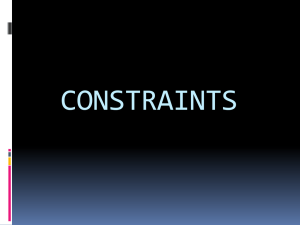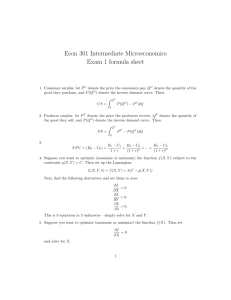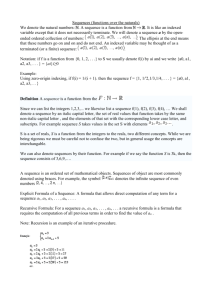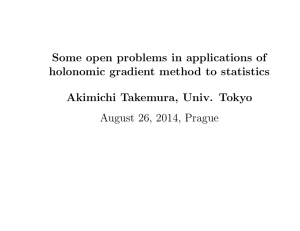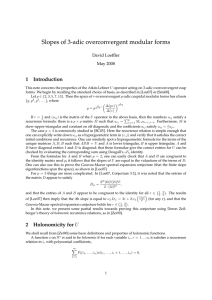18.769: Algebraic D-modules. Fall 2013 Instructor: Pavel Etingof
advertisement
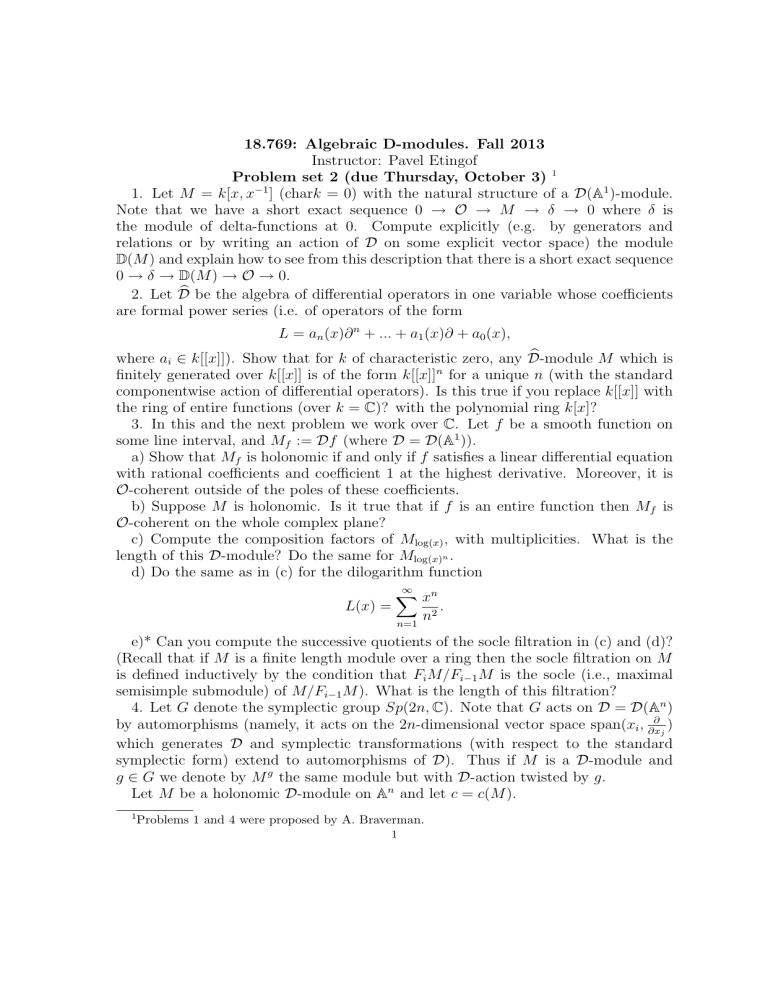
18.769: Algebraic D-modules. Fall 2013 Instructor: Pavel Etingof Problem set 2 (due Thursday, October 3) 1 1. Let M = k[x, x−1 ] (chark = 0) with the natural structure of a D(A1 )-module. Note that we have a short exact sequence 0 → O → M → δ → 0 where δ is the module of delta-functions at 0. Compute explicitly (e.g. by generators and relations or by writing an action of D on some explicit vector space) the module D(M ) and explain how to see from this description that there is a short exact sequence 0 → δ → D(M ) → O → 0. b be the algebra of differential operators in one variable whose coefficients 2. Let D are formal power series (i.e. of operators of the form L = an (x)∂ n + ... + a1 (x)∂ + a0 (x), b where ai ∈ k[[x]]). Show that for k of characteristic zero, any D-module M which is n finitely generated over k[[x]] is of the form k[[x]] for a unique n (with the standard componentwise action of differential operators). Is this true if you replace k[[x]] with the ring of entire functions (over k = C)? with the polynomial ring k[x]? 3. In this and the next problem we work over C. Let f be a smooth function on some line interval, and Mf := Df (where D = D(A1 )). a) Show that Mf is holonomic if and only if f satisfies a linear differential equation with rational coefficients and coefficient 1 at the highest derivative. Moreover, it is O-coherent outside of the poles of these coefficients. b) Suppose M is holonomic. Is it true that if f is an entire function then Mf is O-coherent on the whole complex plane? c) Compute the composition factors of Mlog(x) , with multiplicities. What is the length of this D-module? Do the same for Mlog(x)n . d) Do the same as in (c) for the dilogarithm function ∞ X xn L(x) = . n2 n=1 e)* Can you compute the successive quotients of the socle filtration in (c) and (d)? (Recall that if M is a finite length module over a ring then the socle filtration on M is defined inductively by the condition that Fi M/Fi−1 M is the socle (i.e., maximal semisimple submodule) of M/Fi−1 M ). What is the length of this filtration? 4. Let G denote the symplectic group Sp(2n, C). Note that G acts on D = D(An ) by automorphisms (namely, it acts on the 2n-dimensional vector space span(xi , ∂x∂ j ) which generates D and symplectic transformations (with respect to the standard symplectic form) extend to automorphisms of D). Thus if M is a D-module and g ∈ G we denote by M g the same module but with D-action twisted by g. Let M be a holonomic D-module on An and let c = c(M ). 1 Problems 1 and 4 were proposed by A. Braverman. 1 a) Show that for generic g ∈ G the module M g is O-coherent of rank c (hint: think what the transformation M 7→ M g does to the arithmetic singular support of M and then formulate a sufficient condition for O-coherence in terms of the arithmetic singular support). Note that this gives another definition of c. b) Explain what a) says explictly for M = δa (where a ∈ C). c) Let S(Rn ) denote the Schwartz space of Rn , i.e. the space of functions all of whose partial derivatives are rapidly decreasing at ∞. Let S ∗ (Rn ) denote the appropriate topological dual space. It has a natural structure of D-module. This is the space of tempered distributions on Rn . The Stone-von Neumann theorem says (in particular) that (S ∗ (Rn ))g is isomorphic to S ∗ (Rn ) for every g ∈ Sp(2n, R) (the corresponding isomorphisms were explictly written by Weil). Show that for every holonomic D-module M we have dim HomD (M, S ∗ (Rn )) ≤ c(M ). In other words, the space of solutions of M in the space of tempered distributions has dimension ≤ c(M ) (hint: use a). 2




